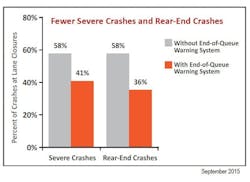Temporary portable rumble strips reduce accidents in Texas work zones
The Texas Department of Transportation (TxDOT) End-of-Queue Warning System was first covered in Plastic Safety Systems’ March 2013 Case Study. An update was provided in a May 2015 Case Study. The following update combines the previously published information with newer information.
A concern for safety:
The I-35 Corridor Project consists of 18 different projects (many concurrent), over 90 miles in length, with ADTs of 55,000–115,000 vehicles, of which about two-thirds are trucks. At night, the percentage of trucks climbs to 75%.
TxDOT prohibited daytime lane closures, so I-35 lanes were closed only at night. The primary safety concern was the potential for high-speed, rear-end crashes, especially as traffic slowed, or queues developed due to lane closures.
The concern was significant:
- I-35 runs through rural areas, where drivers do not expect queues;
- The location of the lane closures changed frequently, and drivers could not acclimate themselves to any location; and
- As noted above, the nighttime ADT is 75% truck traffic, which would increase the severity of any crashes.
Reducing crashes:
To mitigate work-zone crashes, TxDOT developed the End-of-Queue (EOQ) Warning System. As used on the I-35 project, the warning system was comprised of three individual countermeasures:
First countermeasure: Plastic Safety Systems’ RoadQuake 2F Temporary Portable Rumble Strips (TPRS) were installed prior to nighttime lane closures. Drivers simultaneously feel the vibrations and hear the significant “ba-dump” sound as they drive over the strips.
Before reaching the lane closure, drivers will cross another group of rumble strips.
Second countermeasure: Drivers then encounter a portable changeable message sign (PCMS) that transmits current traffic information. An ITS queue warning system, deployed at the merging taper, relays real-time traffic information to the PCMS.
The messages displayed on the PCMS warn drivers of slowed or stopped traffic ahead.
Third countermeasure: New speed limit signs, deployed ahead of each work zone. The signs warn of the 60 mph speed limit for nighttime closures.
How the system worked:
TxDOT developed two EOQ Warning System configuration and deployment plans, the first for queues up to 3.5 miles long, the second for queues up to 7.5 miles long.
The first plan:
- Four speed sensors, from the merging taper to about 2.5 miles upstream;
- PCMS Sign, about 3.5 miles upstream; and
- Series of TPRS, beginning at 3.75 miles upstream.
For the longer queue situation, TxDOT doubled the quantities of the warning system components.
For each lane closure, I-35 project staff compared anticipated traffic volume to the traffic capacity of the work zone. If the staff forecasted queues, they issued the deployment plan that would cover the maximum queue length. (See illustration: EOQ Deployment Plan).
Results:
The TxDOT EOQ Warning System was deployed on over 200 lane closures on the I-35 project.
Results were significant, in both human and financial costs, when the EOQ Warning System was deployed:
- Crashes were reduced by 18 to 45%, when compared to estimates of crashes without the warning system;
- Specifically, rear-end collisions and severe crashes were reduced. (See “Severe and Rear-End Crashes” graph); and
- Crash reductions also saved $1.4 to $1.8 million in societal costs. This represents an ongoing cost savings between $6,600 and $10,000 every time the warning system is deployed.
As the End-of-Queue Warning System proves, innovative countermeasures reduce accidents and save lives.
